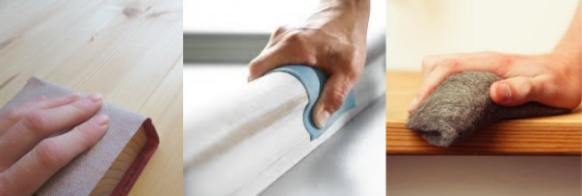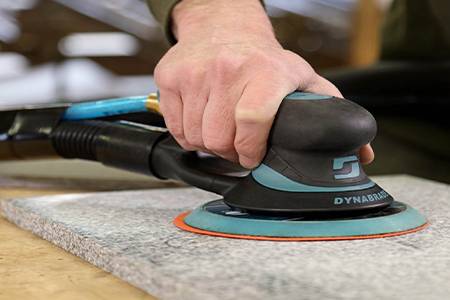¿Necesitas un lijado de precisión sin dañar superficies delicadas? Descubre las ventajas del disco de espuma estándar...
}From a sanding point of view, restoration work on wooden furniture mainly requires time and patience, as well as the use of suitable abrasive products. During these works, we must avoid, as far as possible, the use of manual sanders that save time, but that on the contrary are prone to causing damage to the surface and therefore to the final finish.
The process of sanding by hand is simple and does not require great technique. It should be remembered that with sanding we get the following benefits:
Clean the wood surface and eliminate surface defects, as well as reduce the repellency or grain of the wood.
Create a surface roughness sufficient to allow anchoring of the varnish.
Improve the final finish, giving it a smooth, soft and pleasant touch.
Sometimes they can enhance a rustic, aged appearance or with a marked design on the surface.
Basic recommendations to take into account when sanding wood by hand
As far as possible, we must always sand in favor of the grain of the wood or in favor of the effect or design that is marked on the surface. We must avoid sanding in a cross direction, since in this way the scratches caused would be more visible, while lifting the grain of the wood.
Exert minimal sanding pressure to achieve a uniform finish. If sanding is carried out with excessive pressure, areas with shine, polished, soft to the touch, but with a non-uniform roughness that will result in inhomogeneous colors in the dyeing or coloring phase are generated. In the same way, we can find varnish anchoring problems if the sanded surface has been previously polished by excessive pressure.
It is very important not to rush the abrasives used and replace them when we begin to detect the first signs of wear.
We should not sand wet wood surfaces. The moisture in the wood fibers prevents them from standing up and can be easily removed during sanding. In addition, the dust generated becomes a kind of paste that covers up the abrasive. If we are forced to work on a surface that has been previously moistened then we must wait until it is completely dry. In this way we will achieve the opposite effect, that is to say, the fibers when drying have bristled and it is easier to cut.
It is recommended to clean the wood surface of the dust generated, especially between sanding with different grains since the sanding dust can scratch the wood.
What sanding techniques should we use in manual sanding?
For hand sanding of flat surfaces, it is recommended to use a sanding block. This cleat-like block transmits a uniform sanding pressure over the entire surface, avoiding finger pressure traces on the abrasive itself and this in turn on the piece. The block should have a medium hardness, sufficient to smooth out defects on the sanded surface.
For curved surfaces, it is better to use a padded foam block, which adapts to the different undulations providing a uniform and comfortable sanding. The hardness of the foam should prevent the pressure areas of the fingers from being marked.
For hard-to-reach corners or corners, it is recommended to use a scraper that is sharp and allows us to treat the area without leaving streaks or scratches.
For sanding legs, spindles and other round areas, the use of blocks or cleats is not required. To treat these surfaces it will only be necessary to wrap a strip of cloth or abrasive paper around the piece, and pull the ends back and forth in a continuous up and down movement to sand the entire piece. For sanding this type of part, it is recommended to use a coarser grain of sand than that used for flat surfaces, which will allow us to better sand the heads and cross-grain of the wood.
The sanding of convexly curved edges will be done by lightly pressing the abrasive support with your fingers. For concave curves, we can help ourselves with a pin that has the same diameter as the curve and on which we will wrap the abrasive support.
The sanding of carvings or engravings on the wood must be done with a finer sandpaper grain than that used in the rest of the areas. With this, we must avoid using coarse grains that can blur the drawing or flatten the rounded surfaces.
Veneered or patina surfaces should be treated with care, as they are sensitive coatings. In both cases the sanding must be smooth, with very little pressure, avoiding the peeling of the sheet or the removal of the patina layer. For this type of sanding it is recommended to use abrasive fiber and/or steel wool.
What abrasives can we use for hand sanding wood?

The most common abrasives used for hand sanding are: sanding sheets or sheets, abrasive sponges and steel wool.
Sanding sheets are the most widely used option for sanding operations, especially when working on large surfaces. They are used on cleats or manual clamps on which the abrasive sheets are fixed, thus achieving greater performance and flatness of the sanded pieces.
Abrasive sponges are highly valued for their versatility and user comfort of use, allowing them to be used in small or difficult-to-access places, such as doors or window frames, that have contours or edging. They are used for finishing, stripping, removing small defects or sanding between coats of primer. They can be coarse or fine type.
Steel wool is ideal to be used before finishing because it makes the surface smoother and is in the best condition for the rest of the processes. Steel wool, which is made up of steel wire, has many applications, whether it is fine (to tone varnishes or apply waxes to wood), medium (smooth between coats and finishing before varnishing or painting) or coarse (removal of old wax, stains, stripping ...
At Abracom Madera we also offer you a complete range of sandpaper rolls, with different types of support, so that you can choose the abrasive solution that best suits your sanding needs in each case:
Sandpaper rolls with flexible paper backing
Sanding rolls with rigid paper backing
Sandpaper rolls with velcro backing
Sandpaper rolls with sponge paper backing
Sandpaper rolls with flexible, semi-flexible or rigid cloth backing
Feel free to contact us for more information on all our abrasive products for wood.























 (1).png)
 (1).png)
.png)
.png)
.png)

.png)
.png)
.png)
.png)
.png)
.png)
.png)
.png)
.png)
.png)
.png)
.png)
.png)







